Method for Forecasting the Remaining Useful Life of a Furnace Transformer Based on Online Monitoring Data
Abstract
1. Introduction
- -
- Implementing the control hardware and software for a set of parameters, reliably determining the technical condition;
- -
- Improving the online state diagnosing and RUL forecasting techniques.
2. Literature Review
2.1. The Relevance of Improving the RUL Forecasting Techniques
- -
- The need for processing large amounts of data, including their historical changes;
- -
- Complexity determined by the use of special mathematical analysis techniques and software;
- -
- The need for staff training.
2.2. Online Monitoring of the Furnace Transformer Health
2.3. Analysis of Degradation Models
- The literary sources fail to provide any technique for calculating the transformer RUL by the online monitoring results, considering failures and subsequent recovery; however, they describe the developments for other assets;
- Known equipment health analysis techniques, including SOTA, are not used to forecast the RUL based on the online monitoring results. Their practical implementation is limited since they require special software and staff training. Therefore, a technique that is free of these shortcomings and calculates the RUL should be developed;
- The developed technique should be based on a statistical analysis of the diagnostic parameters that identify the degradation of insulation. The online DGA results are the most informative indicators of such processes;
- The literature review has shown that when estimating the RUL of furnace transformers, hard failures and cumulative shocks caused by dynamic overloads should be considered. Such overloads are associated with the arc metal melting technology specifics and transient processes during the transformer switches occurring up to 100 times per working day. These conditions set specific requirements for the RUL forecasting technique being created, which are discussed in the next section.
3. Problem Statement
3.1. Dependencies of Transformer Failure Tolerance on the Operating Time
3.2. Specifics of the System for Online Monitoring of the Furnace Transformer Health
- -
- Rated Capacity: 26,000–20,282 kVA;
- -
- Rated Coil Voltage: 110,000 HV; 421–289.5 LV V;
- -
- Diagram and Group of Coil Connection: Y/Δ-11;
- -
- Number of OLTC Positions: 9;
- -
- Cooling System: Suspended “OFWF”;
- -
- Mass, 80 Tons;
- -
- Length × Width × Height: 4840 × 3540 × 6200 mm.
- -
- DGA, moisture content control;
- -
- Monitoring of partial discharges;
- -
- Oil temperature control;
- -
- Vibration control;
- -
- Health monitoring of HV bushings, cooling systems, OLTC.
- -
- High concentrations of hydrogen (H2) and acetylene (C2H2) may indicate high current arcing;
- -
- Hydrogen and lower hydrocarbons diagnose discharge phenomena;
- -
- Significant content of methane (CH4) and ethane (C2H6) indicate local overheating or hot spots;
- -
- Emissions of carbon monoxide (CO) and carbon dioxide (CO2) occur when the paper insulation is overheated due to prolonged overload, heat transfer disturbance, or cooling system malfunction.
3.3. Requirements for the Technique Developed
- -
- Forecasting the RUL, considering gradual degradation and wear;
- -
- Simulating hard impacts—resource changes due to failures and recoveries of the state.
- It is advisable to develop the technique using the example of the online DGA results for a furnace transformer, but it should be applicable to other facilities and diagnostic parameters presented in the trend form. Thus, the methodology should be universal;
- The parameter samples should be uniform, smoothed, and include a net of sharp changes not related to failures and resource recovery;
- Processing should be based on known statistical methods; the software used should be available. This requirement is important since the technique is intended for use by the operational services of power facilities and industrial enterprises;
- Sudden state changes should be considered:
- -
- A result of failure, i.e., deterioration of the state, accompanied by a rapid decrease in the resource;
- -
- After repair, as a result of which the state is completely or partially recovered and the resource increases;
- The health criterion generalized for the total of diagnostic features should be justified. As shown below, it is advisable that such an indicator takes the equipment’s integral failure tolerance index, calculated by the defect development dynamics.
4. Materials and Methods
4.1. Analytical Dependencies for the RUL Calculation
4.2. Example of Calculating the Furnace Transformer RUL
- The assumption of a shock change in the resource after repair (and in case of failure) is rightful;
- After the taken measures, the transformer resource was not fully recovered, i.e., the defect causes were only partially eliminated. This is confirmed by the increase in the concentrations of gases, as seen in Figure 7b;
- After the resource recovery, the RUL trends calculated according to both boundary criteria (Dependencies 1 and 2 in Figure 8b) are in quasi-steady states.
4.3. Defining Relative Failure Tolerance
5. Implementation
5.1. Analyzing Source Data Arrays
- -
- Deterioration of the transformer state from 5 May to 23 December 2019 (each parameter sample is approximately 2400 points);
- -
- Repair from 23 December 2019 to 10 January 2020;
- -
- Recovered state from 10 January 2020 to 15 March 2020 (sample of 820 points).
5.2. RUL Calculation Results
5.3. Defects Identified when Dismantling the Windings
6. Discussion of the Results
- Samples are complete since each parameter is measured several hundred times, and this number can be increased by increasing the polling duration or frequency. The possibility of building the trends of changes in the resource and estimating them at any time should also be noted, which is important with the intensive development of destructive processes;
- Since analytical dependencies are used to calculate the RUL, there is no need to provide statistical data on failures and the run-to-failure of healthy equipment (most known techniques require such data). The state is assessed by comparing current data with settings for each controlled parameter. In this case, the state gradation can be set by not only the criteria “normal”, “degraded”, “pre-emergency” adopted in the examples given but also an extended list of criteria. Thus, the five-level classification recommended by IEC 997 [91] can be applied, as shown in Table 4 (without considering the “normal” state);
- The technique’s algorithms can be integrated into the software of existing online monitoring systems with virtually no complication. Thereat, the algorithmic language of the software does not matter.
7. Conclusions and Future Work
- Presentation of the online monitoring results as a time series, reduction to a single time scale, and smoothing using the moving average method;
- Direct calculation of the transformer’s failure tolerance and RUL by Equations (2)–(5);
- Analyzing the impact of shock state changes (failures and recoveries) on the facility’s RUL. Calculating ΔSfi by Equation (6);
- Defining the generalized dynamic index by Equation (8). Justifying the acceptance of the facility’s relative failure tolerance index called the “external impact robustness index” as a generalized parameter;
- Estimating the reliability by comparison with the results of an experimental assessment or the analysis of the state by other diagnostic methods (where appropriate).
- The known techniques are not intended for use in online health monitoring systems, the implementation of which is a priority IOT area;
- The known techniques are aimed at developing methods for processing diagnostic data arrays. It assumes collecting the necessary data over a long period (usually many years), and the only problem is their efficient processing. However, a literature review and the transformer (and other industrial) equipment’s operating practice shows that the necessary data arrays are usually unavailable. Therefore, there is a huge gap between the theoretical development of the RUL forecasting techniques and their industrial implementation;
- Complexity, since all existing RUL forecasting techniques require special mathematical data processing methods (deep learning methods, etc.) and highly qualified staff. This limits the possibility of implementing them in production;
- The known techniques fail to consider the shock RUL change during accidents or resource recovery due to maintenance and repairs. The cumulative failure impact are not considered. This reduces the RUL forecast’s reliability for operating facilities.
- The developed technique is intended for use in the transformer health online monitoring systems (for the first time). Considering that almost all newly commissioned transformers are equipped with such systems, this field has broad prospects;
- The technique has been developed using the example of a furnace transformer which is the specific industrial facility, at which this technique was implemented. Its reliability and technical efficiency have been verified experimentally, which is something that the available literature was lacking. This stresses the practical orientation of the study;
- The technique is based on analytical equations, it is simple, and does not require special software or staff knowledge. Therefore, it is rightfully related to engineering techniques.
- -
- Developing maintenance and repair schedules;
- -
- Justifying the replacement of equipment;
- -
- Justifying the transition to advanced maintenance technologies based on the state;
- -
- Forming SPTA for equipment.
Author Contributions
Funding
Institutional Review Board Statement
Data Availability Statement
Conflicts of Interest
References
- Yan, W.; Wang, J.; Lu, S.; Zhou, M.; Peng, X. A Review of Real-Time Fault Diagnosis Methods for Industrial Smart Manufacturing. Processes 2023, 11, 369. [Google Scholar] [CrossRef]
- Karandaev, A.S.; Yachikov, I.M.; Radionov, A.A.; Liubimov, I.V.; Druzhinin, N.N.; Khramshina, E.A. Fuzzy Algorithms for Diagnosis of Furnace Transformer Insulation Condition. Energies 2022, 15, 3519. [Google Scholar] [CrossRef]
- Reboldi, R.; Zanoni, S.; Mazzoldi, L.; Marchi, B. TAMINE TES. EAF Smartrafo Solution. Available online: http://www.tamini.it/public/EN/document/attach/eec_20160424%20def.pdf (accessed on 1 April 2023).
- Liu, C.; Cichon, A.; Królczyk, G.; Li, Z. Technology development and commercial applications of industrial fault diagnosis system: A review. Int. J. Adv. Manuf. Technol. 2022, 118, 3497–3529. [Google Scholar] [CrossRef]
- Lei, Y.; Li, N.; Guo, L.; Li, N.; Yan, T.; Lin, J. Machinery health prognostics: A systematic review from data acquisition to RUL prediction. Mech. Syst. Signal Process. 2018, 104, 799–834. [Google Scholar] [CrossRef]
- Wang, M.; Vandermaar, A.J.; Srivastava, K.D. Review of Condition Assessment of Power Transformers in Service. IEEE Electr. Insul. Mag. 2002, 6, 12–25. [Google Scholar] [CrossRef]
- Tsvetaev, S.K.; Pershina, N.F.; Smekalov, S.V.; Dolin, A.P.; Smekalov, V.V. Practice of Diagnostics and Repairs of Power Transformers to Improve the Reliability of Operation and Extend the Service Life. Electronic 2006, 5, 27–31. [Google Scholar]
- Cao, X.; Li, P.; Ming, S. Remaining Useful Life Prediction-Based Maintenance Decision Model for Stochastic Deterioration Equipment under Data-Driven. Sustainability 2021, 13, 8548. [Google Scholar] [CrossRef]
- Matusevych, O.; Kuznetsov, V.; Sychenko, V. The method for increasing the efficiency of equipment’s maintenance in railway traction power supply systems. Arch. Transp. 2018, 47, 39–47. [Google Scholar] [CrossRef]
- Illias, H.A.; Chai, X.R.; Abu Bakar, H.R.; Mokhlis, H. Transformer Incipient Fault Prediction Using Combined Artificial Neural Network and Various Particle Swarm Optimisation Techniques. PLoS ONE 2015, 10, e0129363. [Google Scholar] [CrossRef] [PubMed]
- Badune, J.; Vitolina, S.; Maskalonok, V. Methods for Predicting Remaining Service Life of Power Transformers and Their Components. Power Electr. Eng. 2013, 31, 123–126. [Google Scholar]
- Saha, T.K. Review of Modern Diagnostic Techniques for Assessing Insulation Condition in Aged Transformers. IEEE Trans. Dielectr. Electr. Insul. 2003, 5, 903–917. [Google Scholar] [CrossRef]
- Karandaev, A.S.; Yachikov, I.M.; Khramshin, V.R. Methods of Multi-Parameter Diagnostics of Electric Equipment Condition within On-line Monitoring Systems. Procedia Eng. 2016, 15, 32–38. [Google Scholar] [CrossRef]
- Vdoviko, V.P. Failure Tolerance of Operating High-Voltage Equipment. Electronic 2011, 1, 36–41. [Google Scholar]
- Vdoviko, V.P. Methodology of the System for Diagnosing Operating High-Voltage Electrical Equipment. Energy Saf. Energy Sav. 2010, 1, 25–32. [Google Scholar]
- Mtetwa, S.; Cormack, R. Addressing the Requirements of an Ageing Fleet of Transmission Transformers on the Eskom Transmission Network. In Proceedings of the CIGRE 6th Southern Africa Regional Conference, Cape Town, South Africa, 17–21 August 2009. [Google Scholar]
- C57.92-1981; IEEE Guide for Loading Mineral-Oil-Immersed Power Transformers up to and Including 100 MVA with 55 Degrees C or 65 Degrees C Average Winding Rise, ANSI/IEEE Std. Available online: https://ieeexplore.ieee.org/document/27793 (accessed on 11 May 2023).
- Laayati, O.; El Hadraoui, H.; El Magharaoui, A.; El-Bazi, N.; Bouzi, M.; Chebak, A.; Guerrero, J.M. An AI-Layered with Multi-Agent Systems Architecture for Prognostics Health Management of Smart Transformers: A Novel Approach for Smart Grid-Ready Energy Management Systems. Energies 2022, 15, 7217. [Google Scholar] [CrossRef]
- Ivanov, G.; Spasova, A.; Mateev, V.; Marinova, I. Applied Complex Diagnostics and Monitoring of Special Power Transformers. Energies 2023, 16, 2142. [Google Scholar] [CrossRef]
- Poonnoy, N.; Suwanasri, C.; Suwanasri, T. Fuzzy Logic Approach to Dissolved Gas Analysis for Power Transformer Failure Index and Fault Identification. Energies 2021, 14, 36. [Google Scholar] [CrossRef]
- Su, C.Q. A new fuzzy logic method for transformer incipient fault diagnosis. In Proceedings of the IEEE International Conference on Fuzzy Systems (FUZZ-IEEE), Vancouver, BC, Canada, 24–29 July 2016. [Google Scholar] [CrossRef]
- Husain, Z.; Malik, H.; Khan, M.A. Recent Trends in Power Transformer Fault Diagnosis and Condition Assessment. Bull. Electr. Eng. Inform. 2013, 2, 101–111. [Google Scholar] [CrossRef]
- Tran, Q.T.; Davies, K.; Roose, L.; Wiriyakitikun, P.; Janjampop, J.; Riva Sanseverino, E.; Zizzo, G. A Review of Health Assessment Techniques for Distribution Transformers in Smart Distribution Grids. Appl. Sci. 2020, 10, 8115. [Google Scholar] [CrossRef]
- Karandaev, A.S.; Khramshin, V.R.; Evdokimov, S.A.; Kondrashova, Y.N.; Karandaeva, O.I. Metodology of Calculation of the Reliability Indexes and Life Time of the Electric and Mechanical Systems. In Proceedings of the International Conference on Mechanical Engineering, Automation and Control Systems (MEACS), Tomsk, Russia, 16–18 October 2014. [Google Scholar] [CrossRef]
- Barrios, S.; Buldain, D.; Comech, M.P.; Gilbert, I.; Orue, I. Partial Discharge Classification Using Deep Learning Methods—Survey of Recent Progress. Energies 2019, 12, 2485. [Google Scholar] [CrossRef]
- Karandaev, A.S.; Panferov, V.I.; Yachikov, I.M.; Khramshina, E.A.; Khramshin, R.R. Application of the Method for Identification of Developing Defects in a High-Voltage Transformer. In Proceedings of the 18 International Russian Automation Conference (RusAutoCon), Sochi, Russia, 9–16 September 2018. [Google Scholar] [CrossRef]
- Tenbohlen, S.; Coenen, S.; Djamali, M.; Müller, A.; Samimi, M.H.; Siegel, M. Diagnostic Measurements for Power Transformers. Energies 2016, 9, 347. [Google Scholar] [CrossRef]
- Jin, L.; Kim, D.; Abu-Siada, A.; Kumar, S. Oil-Immersed Power Transformer Condition Monitoring Methodologies: A Review. Energies 2022, 15, 3379. [Google Scholar] [CrossRef]
- Wang, J.; Zhang, X.; Zhang, F.; Wan, J.; Kou, L.; Ke, W. Review on Evolution of Intelligent Algorithms for Transformer Condition Assessment. Front. Energy Res. 2022, 10, 904109. [Google Scholar] [CrossRef]
- Samaitis, V.; Mažeika, L.; Jankauskas, A.; Rekuvienė, R. Detection and Localization of Partial Discharge in Connectors of Air Power Lines by Means of Ultrasonic Measurements and Artificial Intelligence Models. Sensors 2021, 21, 20. [Google Scholar] [CrossRef]
- Mharakurwa, E.T. In-Service Power Transformer Life Time Prospects: Review and Prospects. J. Electr. Comput. Eng. 2022, 2022, 9519032. [Google Scholar] [CrossRef]
- Jahromi, A.; Piercy, R.; Cress, S.; Service, J.; Fan, W. An approach to power transformer asset management using health index. IEEE Electr. Insul. Mag. 2009, 2, 20–34. [Google Scholar] [CrossRef]
- Mohmad, A.; Shapiai, M.I.; Shamsudin, M.S.; Abu, M.A.; Hamid, A.A. Investigating performance of transformer health index in machine learning application using dominant features. J. Phys. Conf. Ser. 2021, 2128, 012025. [Google Scholar] [CrossRef]
- Jürgensen, J.H.; Godin, A.S.; Hilber, P. Health index as condition estimator for power system equipment: A critical discussion and case study. CIRED Open Access Proc. J. 2017, 1, 202–205. [Google Scholar] [CrossRef]
- Bohatyrewicz, P.; Płowucha, J.; Subocz, J. Condition Assessment of Power Transformers Based on Health Index Value. Appl. Sci. 2019, 9, 4877. [Google Scholar] [CrossRef]
- Bohatyrewicz, P.; Mrozik, A. The Analysis of Power Transformer Population Working in Different Operating Conditions with the Use of Health Index. Energies 2021, 14, 5213. [Google Scholar] [CrossRef]
- Zaldivar, D.A.; Romero, A.A.; Rivera, S.R. Risk Assessment Algorithm for Power Transformer Fleets Based on Condition and Strategic Importance. Algorithms 2021, 14, 319. [Google Scholar] [CrossRef]
- Li, Y.; Tang, M.-J.; Wu, F.-J.; Zhang, G.; Wang, S.-H.; Suwarno, S. Aging Assessment of Power Transformer Using Multi-parameters. Int. J. Electr. Eng. Inform. 2013, 5, 34–44. [Google Scholar] [CrossRef]
- Kang, Z.; Catal, C.; Tekinerdogan, B. Remaining Useful Life (RUL) Prediction of Equipment in Production Lines Using Artificial Neural Networks. Sensors 2021, 21, 932. [Google Scholar] [CrossRef]
- Jia, C.; Zhang, H. RUL Prediction: Reducing Statistical Model Uncertainty Via Bayesian Model Aggregation. In Proceedings of the CAA Symposium on Fault Detection, Supervision and Safety for Technical Processes (SAFEPROCESS), Xiamen, China, 5–7 July 2019; pp. 602–607. [Google Scholar] [CrossRef]
- Wang, S.; Wang, Y.; Liu, X.; Wang, J.; Wang, Z. Health State Assessment of Industrial Equipment Driven by the Fusion of Digital Twin Model and Intelligent Algorithm. Comput. Intell. Neurosci. 2022, 2022, 7324121. [Google Scholar] [CrossRef] [PubMed]
- Pei, J.; An, J.; Wang, W. Navy missile quality status hierarchy and evaluation. Comput. Digit. Eng. 2016, 12, 2309–2313. [Google Scholar]
- Zhou, L.; Feng, Y.; Gu, J. Missile quality assessment based on fuzzy theory. Ordnance Ind. Autom. 2020, 8, 60–66. [Google Scholar]
- An, J.; Xu, T.; Zeng, X.; Li, Z.; Zhu, G. Equipment quality condition assessment under fusion information based on combination weighting. Control. Decis. 2018, 9, 1693–1698. [Google Scholar] [CrossRef]
- Hao, D.; Zhao, J.; Zhang, S.; Fang, Y. Research on military equipment quality evaluation method based on bayes theory. Equip. Environ. Eng. 2016, 4, 168–175. [Google Scholar]
- Xia, M.; Zheng, X.; Imran, M.; Shoaib, M. Data-driven prognosis method using hybrid deep recurrent neural network. Appl. Soft Comput. 2020, 93, 106351. [Google Scholar] [CrossRef]
- Tian, Q.; Wang, H. An Ensemble Learning and RUL Prediction Method Based on Bearings Degradation Indicator Construction. Appl. Sci. 2020, 10, 346. [Google Scholar] [CrossRef]
- Mustaqeem; Ishaq, M.; Kwon, S. Short-Term Energy Forecasting Framework Using an Ensemble Deep Learning Approach. IEEE Access 2021, 9, 94262–94271. [Google Scholar] [CrossRef]
- Shaikh, A.K.; Nazir, A.; Khan, I.; Shah, A.S. Short term energy consumption forecasting using neural basis expansion analysis for interpretable time series. Sci. Rep. 2022, 12, 22562. [Google Scholar] [CrossRef] [PubMed]
- Klaiber, M. A Fundamental Overview of SOTA-Ensemble Learning Methods for Deep Learning: A Systematic Literature Review. Sci. Inf. Technol. Lett. 2021, 2, 1–14. [Google Scholar] [CrossRef]
- Bustamante, S.; Manana, M.; Arroyo, A.; Castro, P.; Laso, A.; Martinez, R. Dissolved Gas Analysis Equipment for Online Monitoring of Transformer Oil: A Review. Sensors 2019, 19, 4057. [Google Scholar] [CrossRef]
- Walker, C.; Walker, D. Creation & Validation of Transformer Residual Life Models. In Proceedings of theIEEE 21st International Conference on Dielectric Liquids (ICDL), Sevilla, Spain, 29 May–2 June 2022. [Google Scholar] [CrossRef]
- Karandaev, A.S.; Radionov, A.A.; Tverskoi, M.M.; Yachikov, I.M.; Nikolaev, A.A. Methods of Estimation of Electrical Equipment Condition Based on Integral Diagnostic Attribute. In Proceedings of the 2nd International Ural Conference on Measurements (UralCon), Chelyabinsk, Russia, 16–19 October 2017. [Google Scholar] [CrossRef]
- Radionov, A.A.; Karandaeva, O.I.; Evdokimov, S.A.; Gallyamova, M.S.; Kondrashova, Y.N. Monitoring Partial Discharges in Stationary Condition Monitoring System of Furnace Transformer. In Proceedings of the IEEE NW Russia Young Researchers in Electrical and Electronic Engineering Conference (EIConRus), St. Petersburg and Moscow, Russia, 1–3 February 2017. [Google Scholar] [CrossRef]
- Karandaev, A.S.; Khramshin, V.R.; Evdokimov, S.A.; Larina, T.P.; Yachikov, I.M. Practical Diagnostics of Power Transformers with Acoustic Radar Method of Partial Discharge Determination. In Proceedings of the IEEE NW Russia Young Researchers in Electrical and Electronic Engineering Conference (EIConRusNW), St. Petersburg, Russia, 2–3 February 2016. [Google Scholar] [CrossRef]
- Panoiu, M.; Panoiu, C.; Sora, I.; Osaci, M. About the Possibility of Power Controlling in the Three-Phase Electric Arc Furnaces Using PSCAD EMTDC Simulation Program. Adv. Electr. Comput. Eng. 2007, 7, 38–43. [Google Scholar] [CrossRef]
- Ge, W.; Zhang, C.; Xie, Y.; Yu, M.; Wang, Y. Analysis of the Electromechanical Characteristics of Power Transformer under Different Residual Fluxes. Energies 2021, 14, 8244. [Google Scholar] [CrossRef]
- Karandaev, A.S.; Evdokimov, S.A.; Khramshin, V.R.; Lednov, R.A. Diagnostic Functions of a System for Continuous Monitoring of the Technical Condition of the Transformers of Arc Steelmaking Furnaces. Metallurgist 2014, 7–8, 655–663. [Google Scholar] [CrossRef]
- Karandaev, A.S.; Evdokimov, S.A.; Khramshin, V.R.; Karandaeva, O.I. Information and Measuring System for Electric Arc Furnace Transformer Monitoring. In Proceedings of the 12th International Conference on Actual Problems of Electronic Insrument Engineering (APEIE), Novosibirsk, Russia, 2–4 October 2014. [Google Scholar] [CrossRef]
- Cano-Plata, E.A.; Soto-Marin, O.J.; Ustariz-Farfan, A.J. Life Assessment of Electric Arc Furnace Transformers. IEEE Trans. Ind. Appl. 2017, 53, 4125–4135. [Google Scholar] [CrossRef]
- Karandaeva, O.I.; Yakimov, I.A.; Filimonova, A.A.; Gartlib, E.A.; Yachikov, I.M. Stating Diagnosis of Current State of Electric Furnace Transformer on the Basis of Analysis of Partial Discharges. Machines 2019, 7, 77. [Google Scholar] [CrossRef]
- Singh, R.P.; Sonawane, A.V.; Satpute, M.S.; Shirsath, D.Y.; Thakre, M.P. A Review on Traditional Methods of Condition Monitoring of Transformer. In Proceedings of the International Conference on Electronics and Sustainable Communication Systems (ICESC), Coimbatore, India, 2–4 July 2020. [Google Scholar] [CrossRef]
- Wani, S.A.; Rana, A.S.; Sohail, S.; Rahman, O.; Parveen, S.; Khan, S.A. Advances in DGA based condition monitoring of transformers: A review. Renew. Sustain. Energy Rev. 2021, 149, 111347. [Google Scholar] [CrossRef]
- Das, B. Transformer Magazine Special Issue: Digitalization—Demystifying Online DGA Monitor Specification. Available online: https://www.researchgate.net/publication/347623087_Transformer_Magazine_Special_Issue_Digitalization_-_Demystifying_online_DGA_monitor_specification (accessed on 11 May 2023).
- Barkas, D.A.; Kaminaris, S.D.; Kalkanis, K.K.; Ioannidis, G.C.; Psomopoulos, C.S. Condition Assessment of Power Transformers through DGA Measurements Evaluation Using Adaptive Algorithms and Deep Learning. Energies 2023, 16, 54. [Google Scholar] [CrossRef]
- Mark Gross Leveraging Online DGA to Optimize End-of-Life Operations for Aging Power Transformers. Available online: https://www.tdworld.com/test-and-measurement/article/21251830/leveraging-online-dga-to-optimize-endoflife-operations-for-aging-power-transformers (accessed on 11 May 2023).
- Shamsudin, M.S.; Yakub, F.; Shapiai, M.I.; Mohmad, A.; Abd, N.A. Hamid Investigation on Online DGA Monitoring to Determine Transformer Health Index Using Machine Learning. J. Phys. Conf. Ser. 2021, 2128, 012024. [Google Scholar] [CrossRef]
- Almoallem, Y.D.; Taha, I.B.M.; Mosaad, M.I.; Nahma, L.; Abu-Siada, A. Application of Logistic Regression Algorithm in the Interpretation of Dissolved Gas Analysis for Power Transformers. Electronics 2021, 10, 1206. [Google Scholar] [CrossRef]
- Apte, S.; Somalwar, R.; Wajirabadkar, A. Incipient Fault Diagnosis of Transformer by DGA Using Fuzzy Logic. In Proceedings of the IEEE International Conference on Power Electronics, Drives and Energy Systems (PEDES), Chennai, India, 18–21 December 2018. [Google Scholar] [CrossRef]
- Yan, T.; Lei, Y.; Li, N.; Wang, B.; Wang, W. Degradation modeling and remaining useful life prediction for dependent competing failure processes. Reliab. Eng. Syst. Saf. 2021, 212, 107638. [Google Scholar] [CrossRef]
- Hao, S.; Yang, J.; Ma, X.; Zhao, Y. Reliability modeling for mutually dependent competing failure processes due to degradation and random shocks. Appl. Math. Model. 2017, 51, 232–249. [Google Scholar] [CrossRef]
- Zhang, Z.; Si, X.; Hu, C.; Kong, X. Degradation modeling–based remaining useful life estimation: A review on approaches for systems with heterogeneity. J. Risk Reliab. 2015, 229, 343–355. [Google Scholar] [CrossRef]
- Bejaoui, I.; Bruneo, D.; Xibilia, M.G. Remaining Useful Life Prediction of Broken Rotor Bar Based on Data-Driven and Degradation Model. Appl. Sci. 2021, 11, 7175. [Google Scholar] [CrossRef]
- Rafiee, K.; Feng, Q.; Coit, D.W. Reliability modeling for dependent competing failure processes with changing degradation rate. IIE Trans. 2014, 46, 483–496. [Google Scholar] [CrossRef]
- Li, Z.; Goebel, K.; Wu, D. Degradation Modeling and Remaining Useful Life Prediction of Aircraft Engines Using Ensemble Learning. ASME J. Eng. Gas Turbines Power 2019, 141, 041008. [Google Scholar] [CrossRef]
- Mitici, M.; de Pater, I. Online Model-Based Remaining-Useful-Life Prognostics for Aircraft Cooling Units Using Time-Warping Degradation Clustering. Aerospace 2021, 8, 168. [Google Scholar] [CrossRef]
- Chen, N.; Tsui, K.L. Condition monitoring and remaining useful life prediction using degradation signals: Revisited. IIE Trans. 2013, 9, 939–952. [Google Scholar] [CrossRef]
- Xu, X.; Yu, C.; Tang, S.; Sun, X.; Si, X.; Wu, L. Remaining Useful Life Prediction of Lithium-Ion Batteries Based on Wiener Processes with Considering the Relaxation Effect. Energies 2019, 12, 1685. [Google Scholar] [CrossRef]
- Zhang, S.-J.; Kang, R.; Lin, Y.-H. Remaining useful life prediction for degradation with recovery phenomenon based on uncertain process. Reliab. Eng. Syst. Saf. 2021, 208, 107440. [Google Scholar] [CrossRef]
- Gómez-Pau, Á.; Riba, J.-R.; Moreno-Eguilaz, M. Time Series RUL Estimation of Medium Voltage Connectors to Ease Predictive Maintenance Plans. Appl. Sci. 2020, 10, 9041. [Google Scholar] [CrossRef]
- Zhong, Q. Power Transformer End-of-Life Modelling: Linking Statistics with Physical Ageing. Available online: https://www.escholar.manchester.ac.uk/item/?pid=uk-ac-man-scw:153730 (accessed on 11 May 2023).
- Francheck, M.A.; Woodcock, D.J. Life-Cycle Consideration of Loading Transformers above Nameplate Rating. Available online: https://studylib.net/doc/18859208/life-cycle-considerations-of-loading-transformers-above-n (accessed on 11 May 2023).
- Marchi, B.; Zanoni, S.; Mazzoldi, L.; Reboldi, R. Energy Efficient EAF Transformer—A Holistic Life Cycle Cost Approach. Procedia CIRP 2016, 48, 319–324. [Google Scholar] [CrossRef]
- Karandaev, A.S.; Evdokimov, S.A.; Khramshin, V.R.; Sarlybaev, A.A. System for Real-Time Monitoring of the Technical State of a Transformer on an Ultrahigh-Power Electric-Arc Steelmaking Furnace. Metallurgist 2014, 9–10, 872–879. [Google Scholar] [CrossRef]
- RD 153-34.0-46.302-00. Guidelines for Diagnosing Defects Developing in Transformer Equipment by the Results of Chromatographic Analysis of Gases Dissolved in Oil. Available online: https://sibenedia.ru/assets/images/RD_153-34_0-46_302-00.pdf (accessed on 11 May 2023).
- ISO/DIS 13849-1.2 (en) Safety of Machinery—Safety-Related Parts of Control Systems—Part 1: General Principles for Design. Available online: https://www.iso.org/obp/ui/#iso:std:iso:13849:-1:dis:ed-4:v2:en (accessed on 11 May 2023).
- Malkin, V.S. Technical Diagnostics; Lan: St. Petersburg, Russia, 2013; 272p. [Google Scholar]
- Radionov, A.A.; Karandaev, A.S.; Yachikov, I.M.; Karandaeva, O.I.; Gasyarov, V.R. Power Transformer Condition Forecast with Time-series Extrapolation. In Proceedings of the 9th International Conference on Computer and Automation Engineering (ICCAE), Sydney, Australia, 18–21 February 2017. [Google Scholar] [CrossRef]
- Rusov, V.A. Diagnostic Monitoring of High-Voltage Power Transformers; DIM-RUS: Perm, Russia, 2012; 159p. [Google Scholar]
- Thang, K.F.; Aggarwal, R.K.; McGrail, A.J.; Esp, D.G. Analysis of Power Transformer Dissolved Gas Data Using the Self-Organizing Map. IEEE Trans. Electr. Power Deliv. 2003, 4, 349–354. [Google Scholar] [CrossRef]
- Methodical Directions for to Diagnostic of Mains Transformers, the Autotransformers, Bypassing Chokes and Their Feedings into MУ 0634-2006. Concern «ROSENERGOATOM». Available online: http://leg.co.ua/knigi/oborudovanie/diagnostika>-transformatorov-i-shuntiruyuschih-reaktorov.htm (accessed on 11 May 2023).
- Khramshin, V.R.; Evdokimov, S.A.; Nikolaev, A.A.; Nikolaev, A.A.; Karandaev, A.S. Monitoring Technical State of the Power Transformers Is a Necessary Condition of the Smart-Grid Technology Introduction within the Industrial Electric Networks. In Proceedings of the IEEE NW Russia Young Researchers in Electrical and Electronic Engineering Conference (EIConRusNW), St. Petersburg, Russia, 2–4 February 2015. [Google Scholar] [CrossRef]
- Karandaev, A.S.; Mugalimov, R.G.; Petushkov, M.Y.; Lukyanov, S.I.; Sarvarov, A.S. Design of smart technical condition analysis systems for electric equipment of an iron-and-steel. In Proceedings of the International Ural Conference on Electrical Power Engineering (UralCon), Chelyabinsk, Russia, 1–3 October 2019. [Google Scholar] [CrossRef]
- Radionov, A.A.; Evdokimov, S.A.; Karandaev, A.S.; Khramshin, V.R. Information and Measurement System for Control of Technical State of Asynchronous Electric Motors with Group Supply from Frequency Converter. In Proceedings of the 12th International Conference on Actual Problems of Electronic Insrument Engineering (APEIE), Novosibirsk, Russia, 2–4 October 2014. [Google Scholar] [CrossRef]
- Khramshin, V.R.; Evdokimov, A.S.; Evdokimov, S.A.; Karandaev, A.S. Development and Industrial Introduction of Systems for Monitoring Technical State of the Rolling Mills’ Electrical Equipment. In Proceedings of the IEEE NW Russia Young Researchers in Electrical and Electronic Engineering Conference (EIConRusNW), St. Petersburg, Russia, 2–4 February 2015. [Google Scholar] [CrossRef]
- Evdokimov, A.S.; Evdokimov, S.A.; Karandaev, A.S.; Radionov, A.A. Strategy of vibration diagnostic control of mill equipment condition. In Proceedings of the International Conference on Mechanical Engineering, Automation and Control Systems (MEACS), Tomsk, Russia, 1–4 December 2015. [Google Scholar] [CrossRef]
- Khramshin, V.R.; Nikolayev, A.A.; Evdokimov, S.A.; Kondrashova, Y.N.; Larina, T.P. Validation of Diagnostic Monitoring Technical State of Iron and Steel Works Transformers. In Proceedings of the IEEE NW Russia Young Researchers in Electrical and Electronic Engineering Conference (EIConRusNW), St. Petersburg, Russia, 2–3 February 2016. [Google Scholar] [CrossRef]
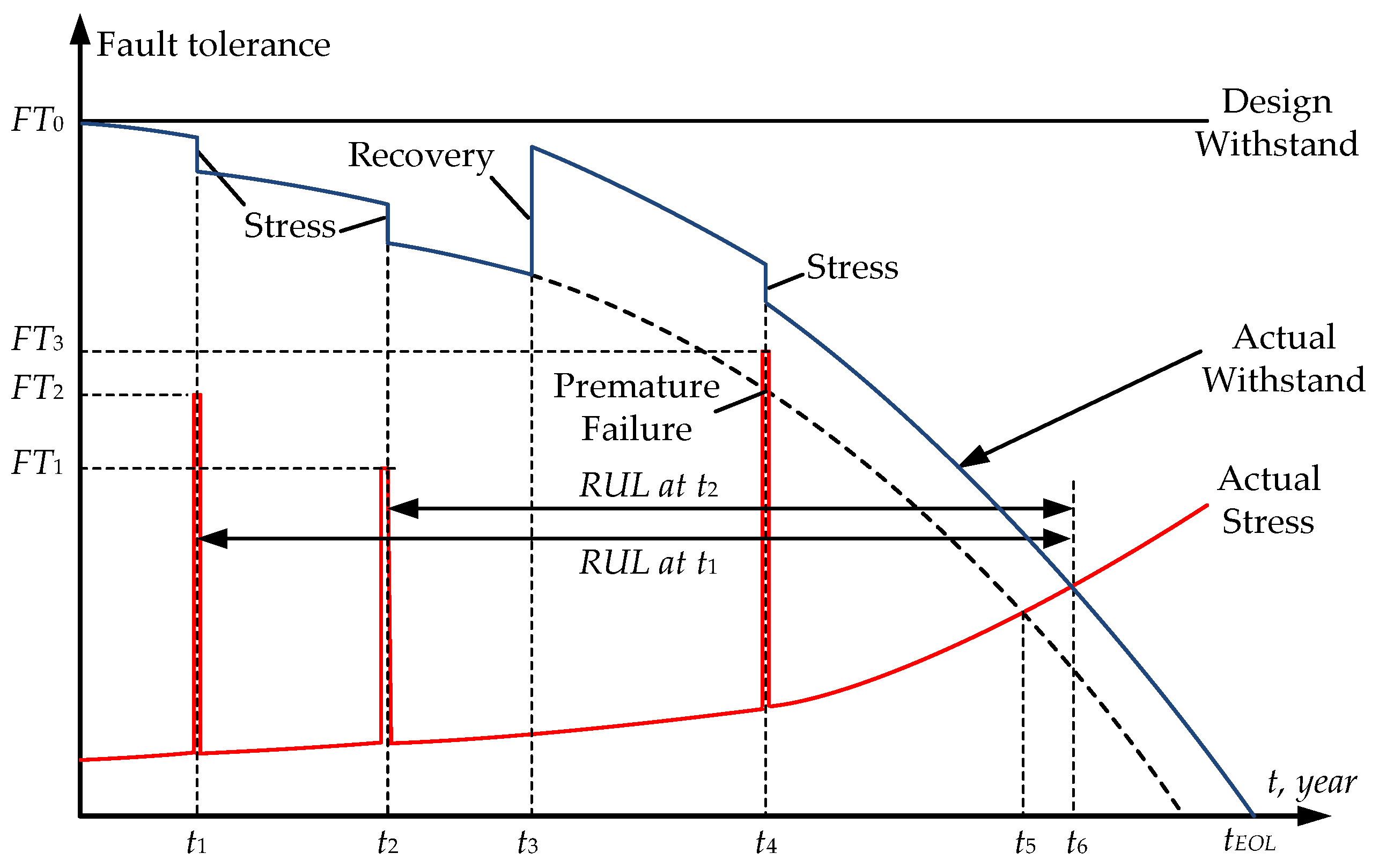
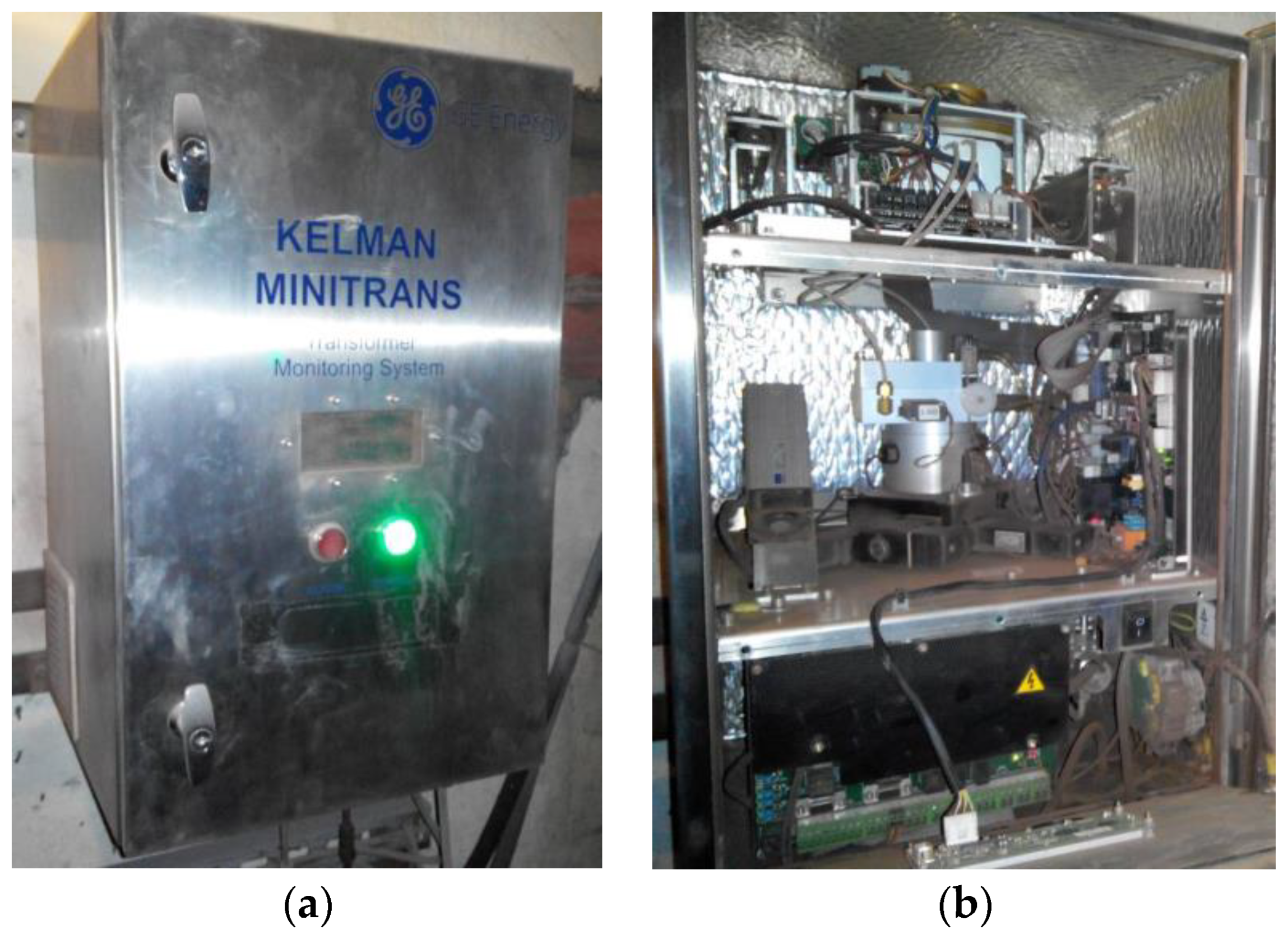
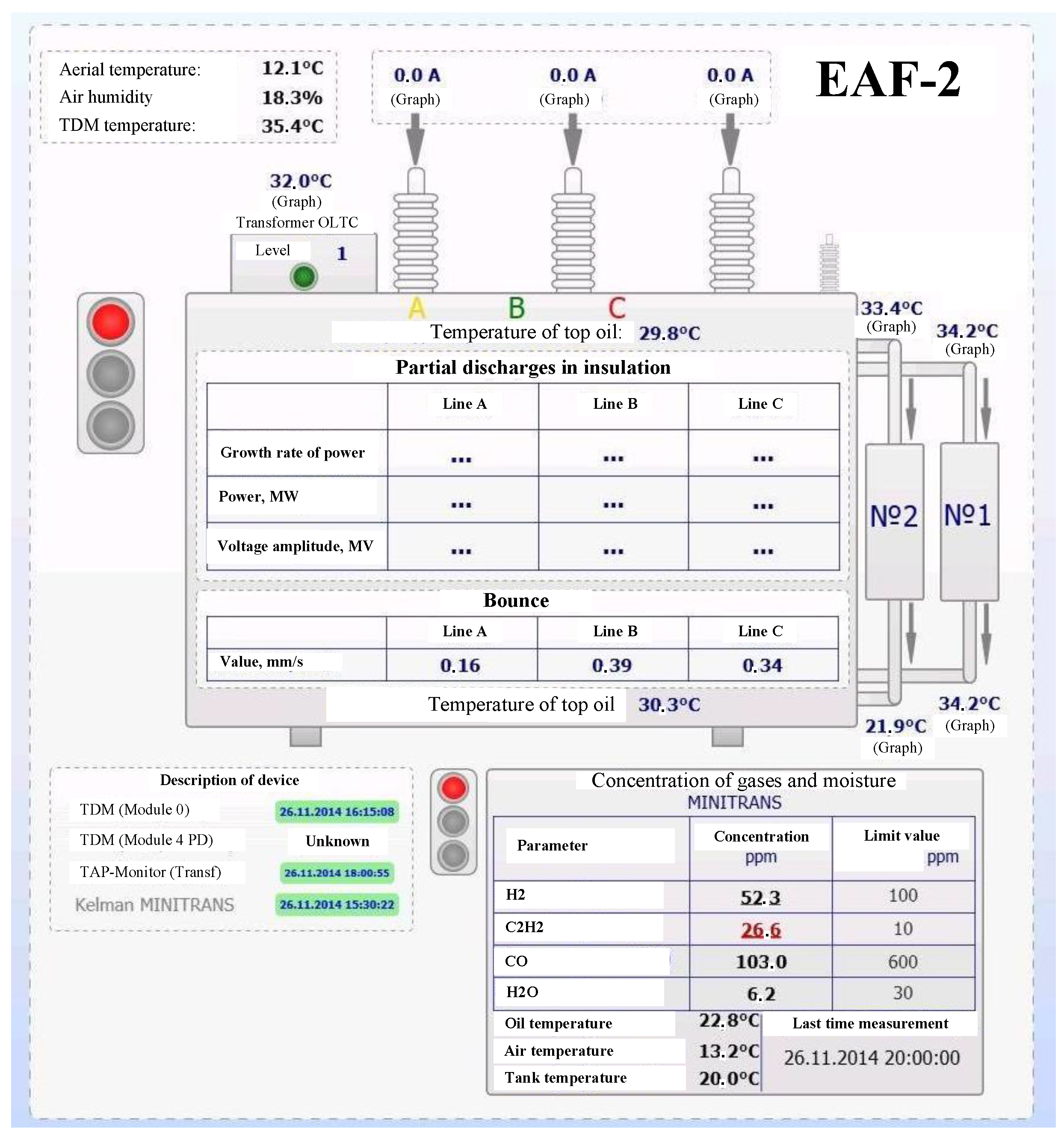
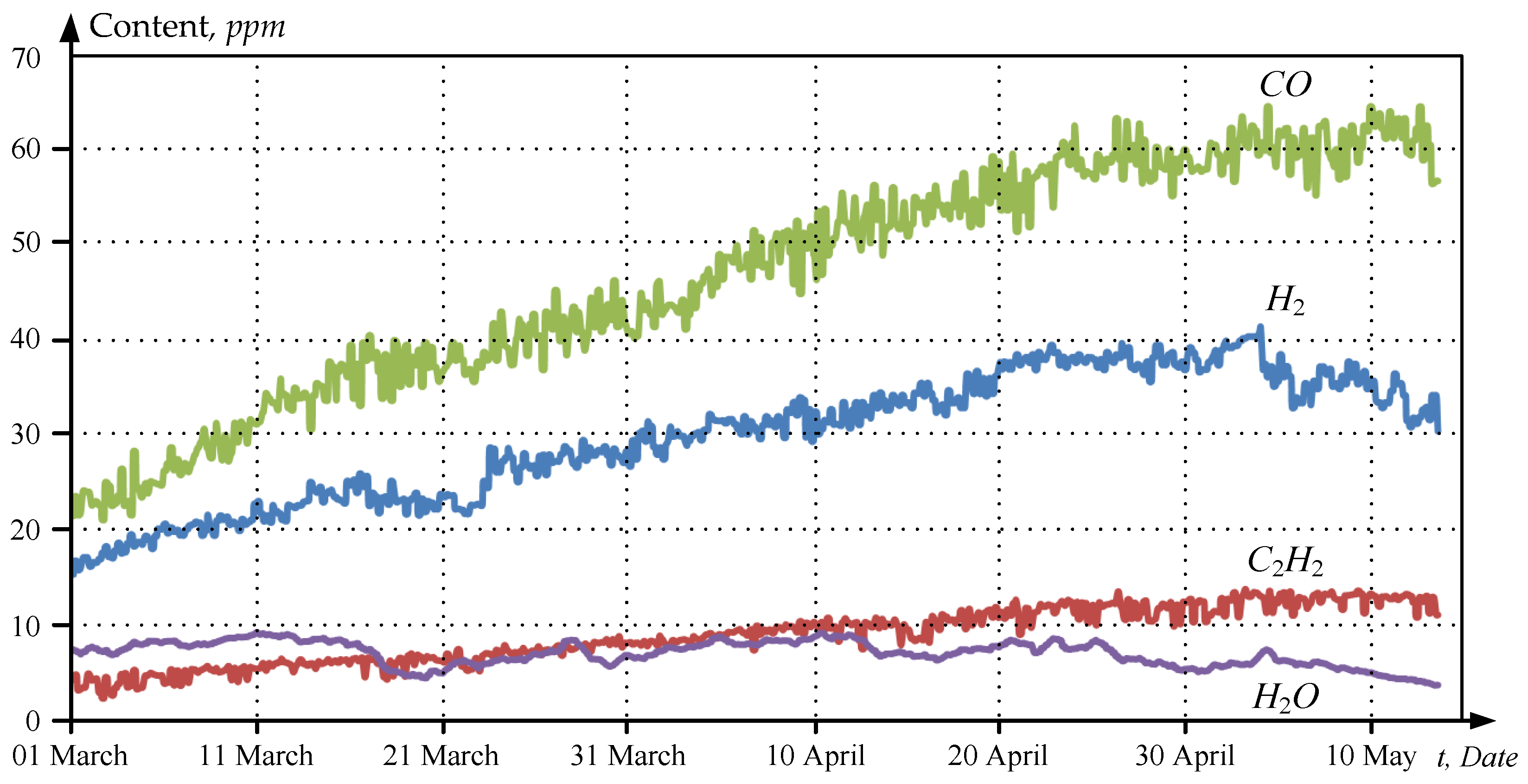
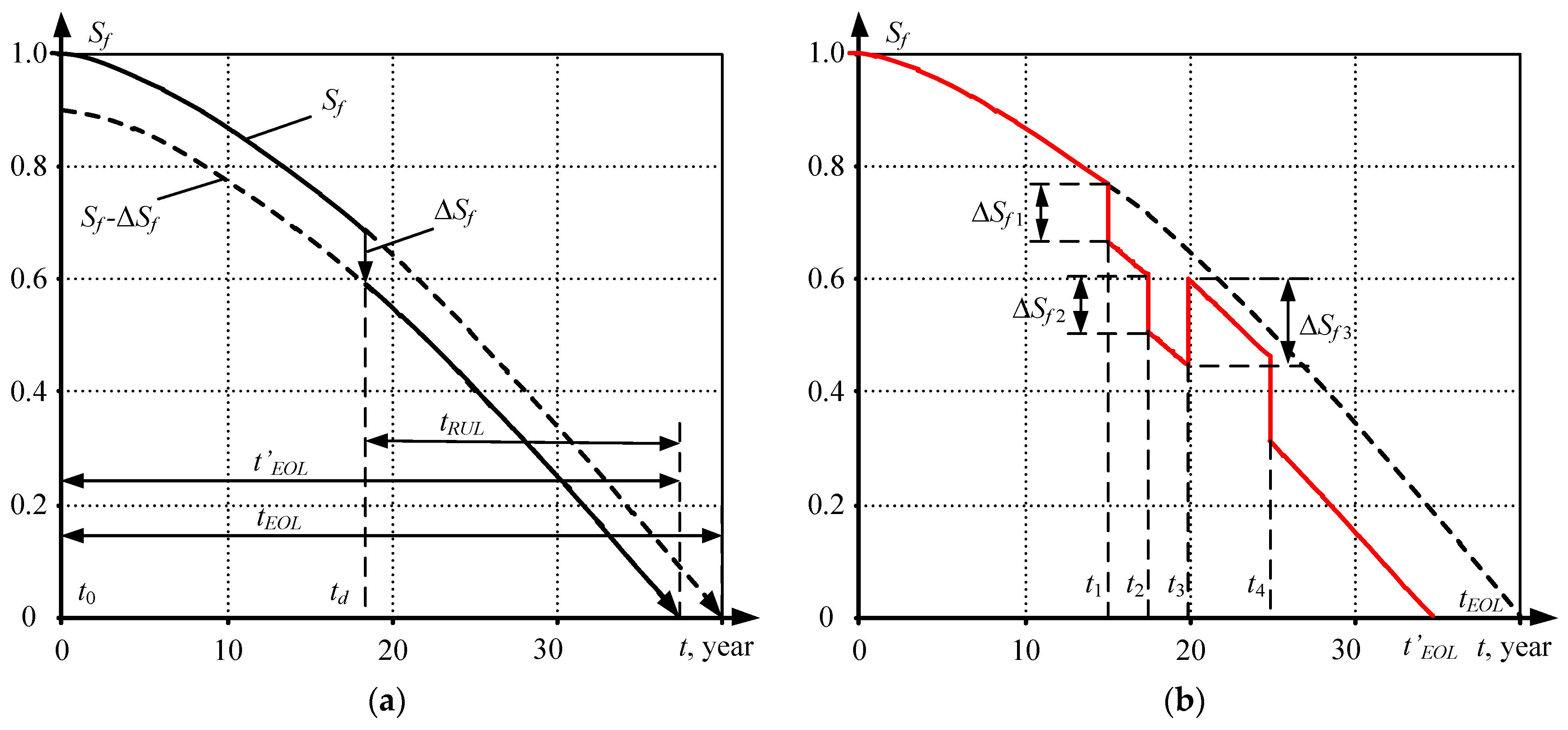
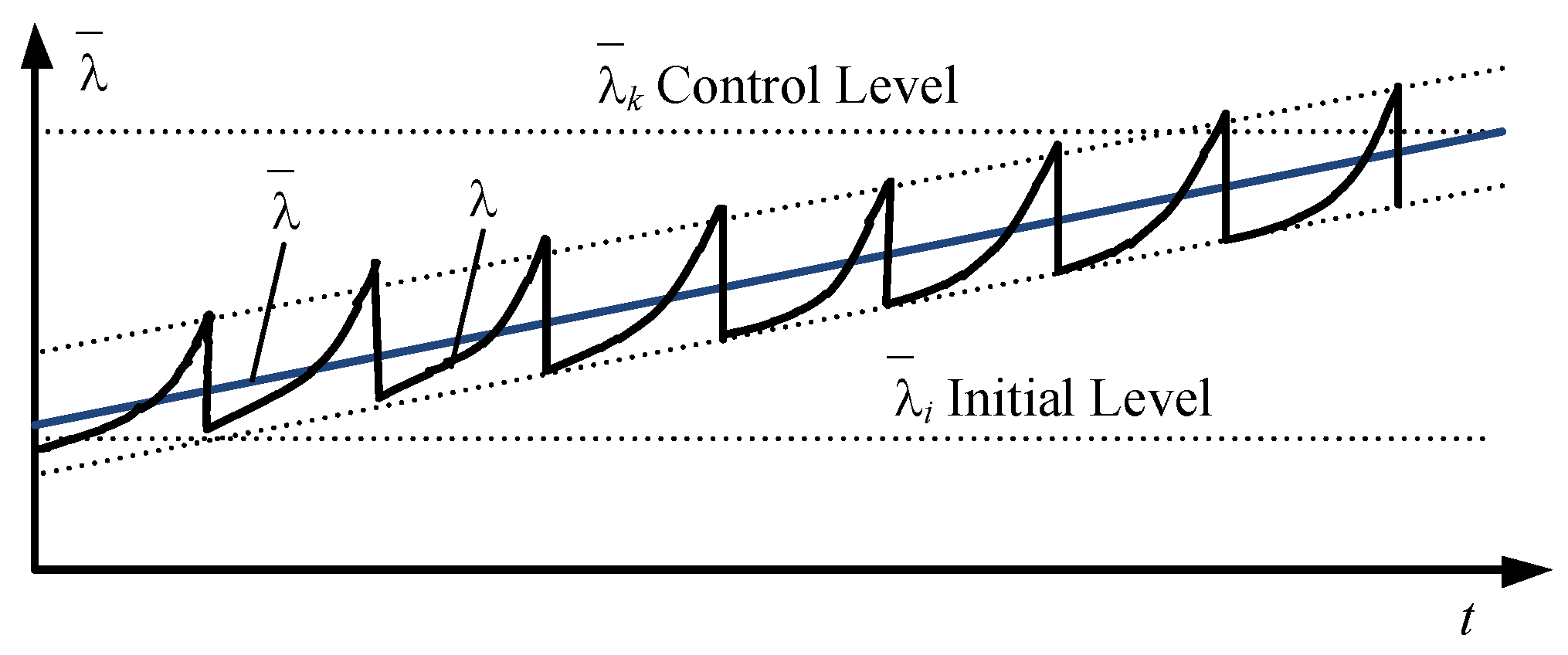

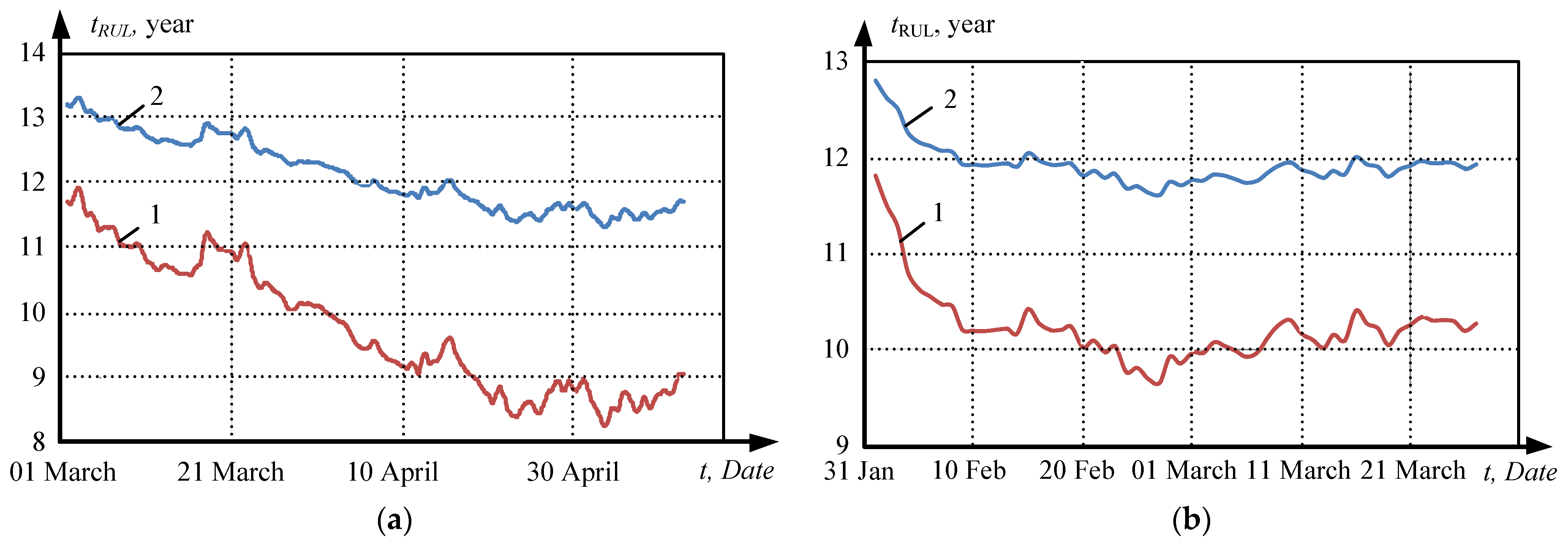
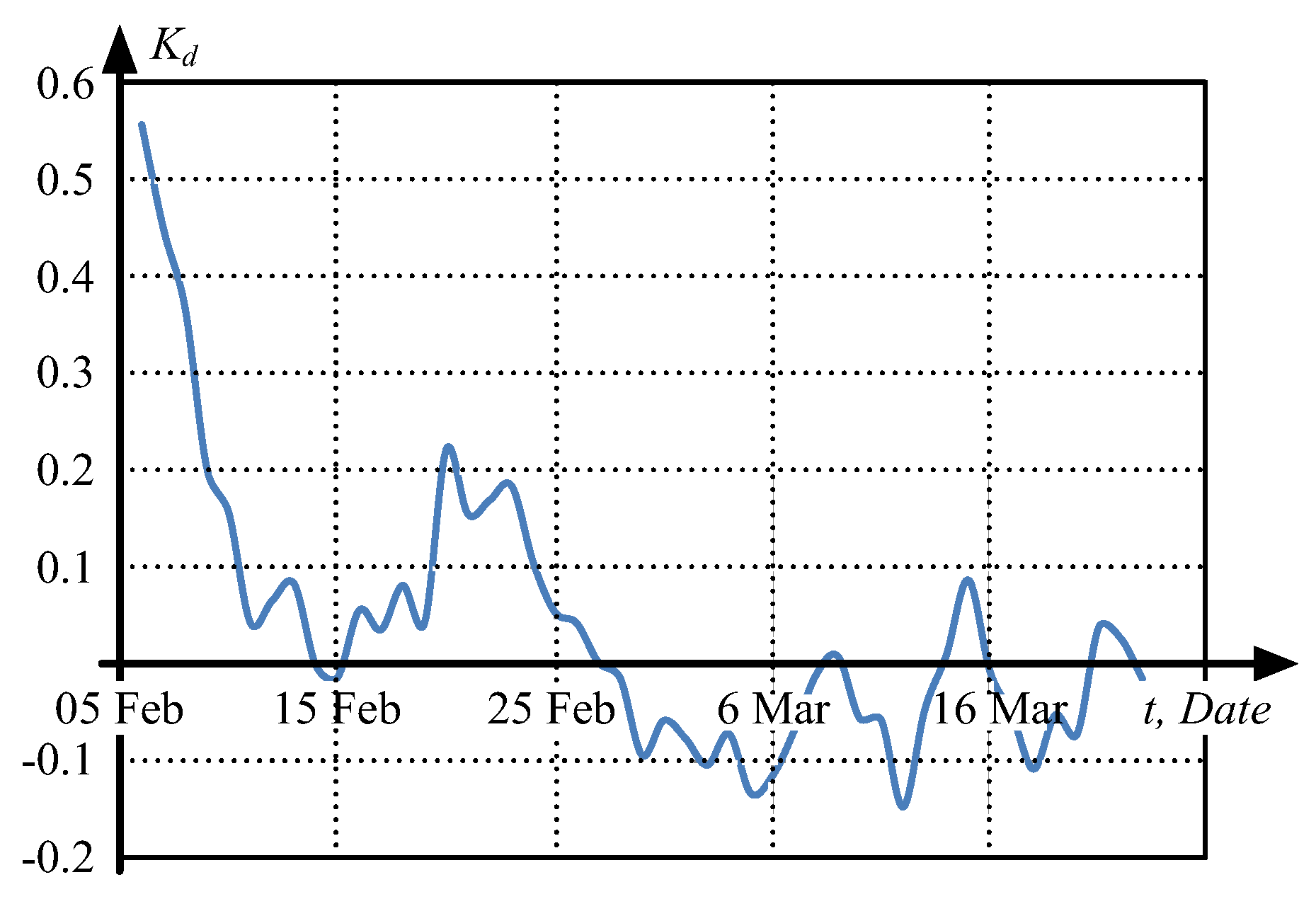
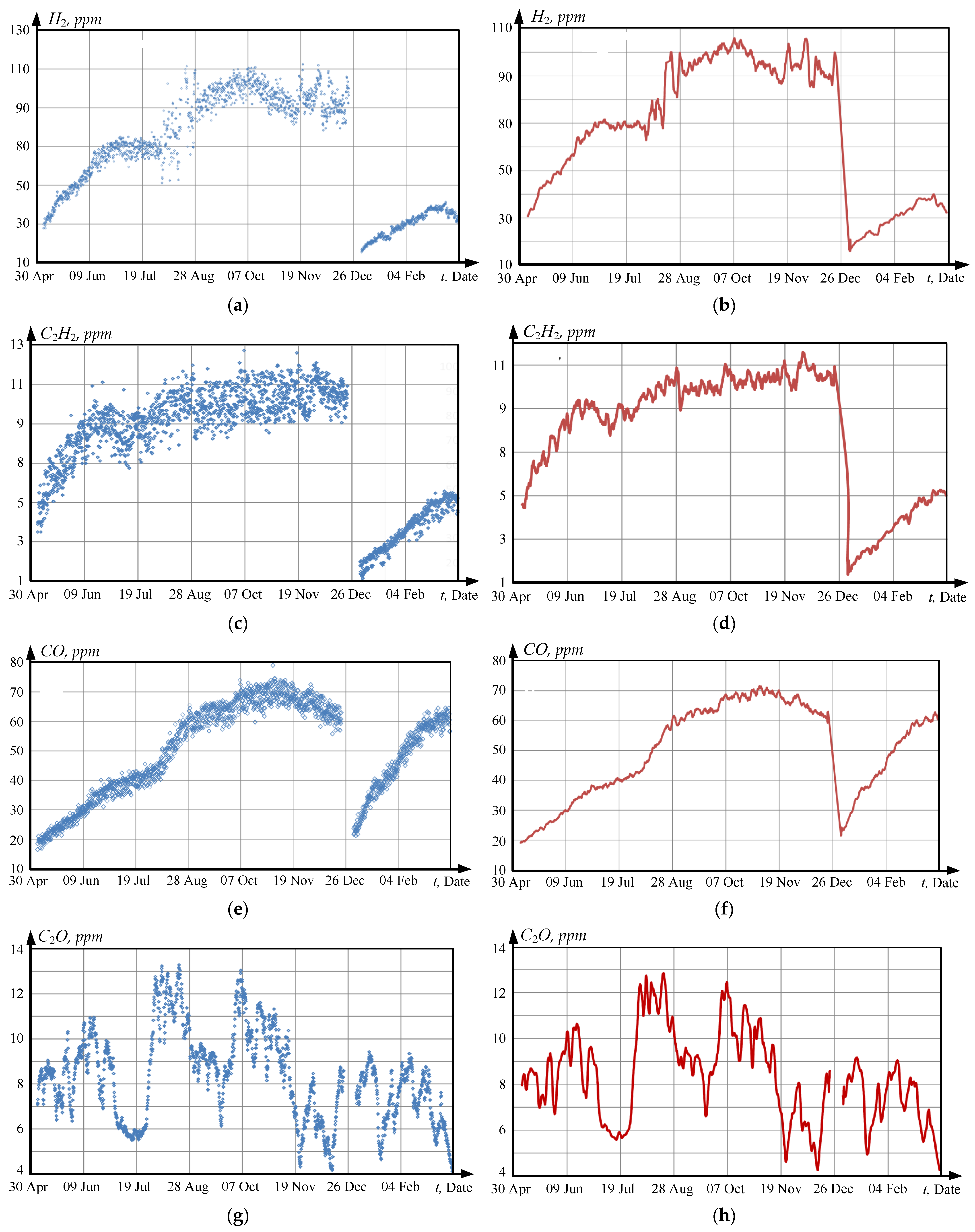


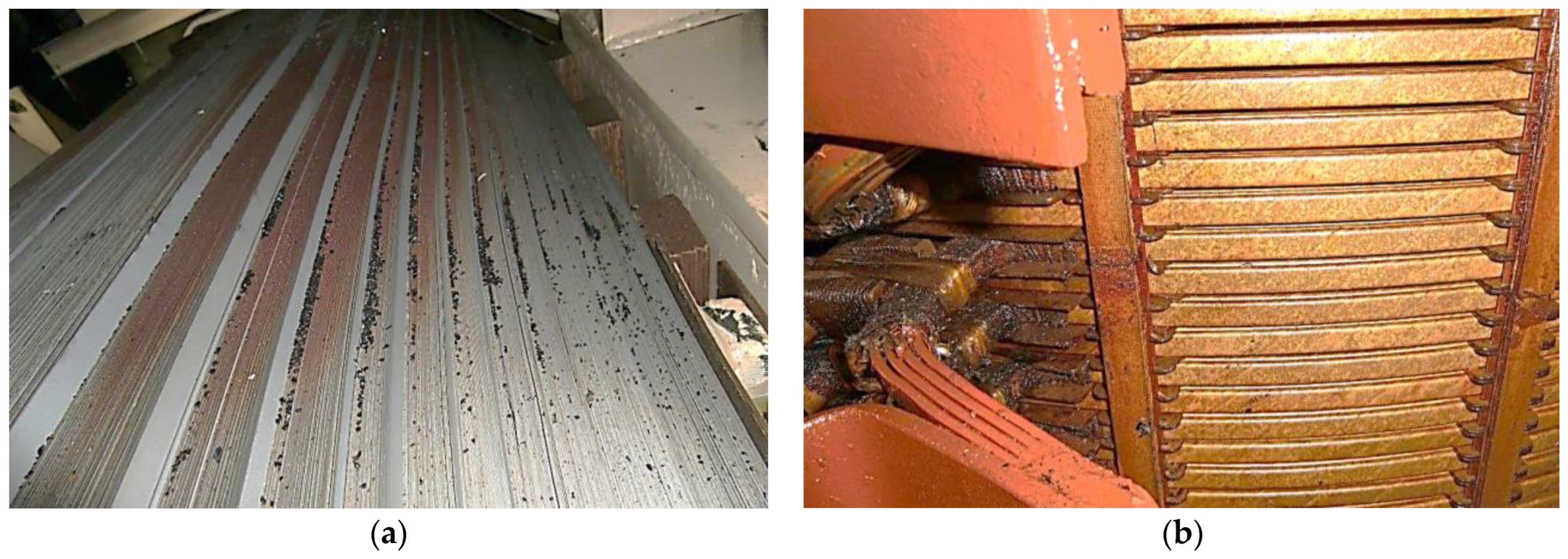
| Measured Gas | Measurement Limit, ppm |
|---|---|
| Hydrogen (H2) | 5–5000 |
| Acetylene (C2H2) | 3–50,000 |
| Carbon monoxide (CO) | 10–50,000 |
| Accuracy | ±10% |
| Humidity (H2O) | 0–100% RS (at 25 °C, or measured oil temperature) |
| q Indicator | |
|---|---|
| Top oil layer temperature | 0.8 |
| Moisture content in oil | 1.0 |
| Concentration of gases dissolved in oil | 0.8 |
| No. | Parameter | ||
|---|---|---|---|
| 1 | Hydrogen content, H2 | 50 ppm | 100 ppm |
| 2 | Carbon monoxide content, CO | 300 ppm | 600 ppm |
| 3 | Moisture content, H20 | 15 ppm | 30 ppm |
| 4 | Acetylene content, C2H2 | 5 ppm | 10 ppm |
| Maximum Kd Corresponding to the Danger Degree | ||||
|---|---|---|---|---|
| Increased | High | Dangerous | Critical | |
| Concentration of gases dissolved in oil | 1.5 | 3.5 | 4 | 5 |
| Moisture content in oil | 1.5 | 3.5 | 4 | 5 |
| Top oil layer temperature | 1.1 | 1.2 | 1.4 | 1.5 |
| Measured Gas | 5 May 2019 | 23 December 2019 | 10 January 2020 | ||||||
|---|---|---|---|---|---|---|---|---|---|
| ppm | Multiplicity | ppm | Multiplicity | ppm | Multiplicity | ||||
| Degraded State | Pre-Emergency | Degraded State | Pre-Emergency | Degraded State | Pre-Emergency | ||||
| Hydrogen (H2) | 30 | 0.6 | 0.3 | 90 | 1.8 | 0.9 | 18 | 0.6 | 0.18 |
| Acetylene (C2H2) | 4 | 0.8 | 0.4 | 10 | 2 | 1 | 2 | 0.4 | 0.2 |
Disclaimer/Publisher’s Note: The statements, opinions and data contained in all publications are solely those of the individual author(s) and contributor(s) and not of MDPI and/or the editor(s). MDPI and/or the editor(s) disclaim responsibility for any injury to people or property resulting from any ideas, methods, instructions or products referred to in the content. |
© 2023 by the authors. Licensee MDPI, Basel, Switzerland. This article is an open access article distributed under the terms and conditions of the Creative Commons Attribution (CC BY) license (https://creativecommons.org/licenses/by/4.0/).
Share and Cite
Radionov, A.A.; Liubimov, I.V.; Yachikov, I.M.; Abdulveleev, I.R.; Khramshina, E.A.; Karandaev, A.S. Method for Forecasting the Remaining Useful Life of a Furnace Transformer Based on Online Monitoring Data. Energies 2023, 16, 4630. https://doi.org/10.3390/en16124630
Radionov AA, Liubimov IV, Yachikov IM, Abdulveleev IR, Khramshina EA, Karandaev AS. Method for Forecasting the Remaining Useful Life of a Furnace Transformer Based on Online Monitoring Data. Energies. 2023; 16(12):4630. https://doi.org/10.3390/en16124630
Chicago/Turabian StyleRadionov, Andrey A., Ivan V. Liubimov, Igor M. Yachikov, Ildar R. Abdulveleev, Ekaterina A. Khramshina, and Alexander S. Karandaev. 2023. "Method for Forecasting the Remaining Useful Life of a Furnace Transformer Based on Online Monitoring Data" Energies 16, no. 12: 4630. https://doi.org/10.3390/en16124630
APA StyleRadionov, A. A., Liubimov, I. V., Yachikov, I. M., Abdulveleev, I. R., Khramshina, E. A., & Karandaev, A. S. (2023). Method for Forecasting the Remaining Useful Life of a Furnace Transformer Based on Online Monitoring Data. Energies, 16(12), 4630. https://doi.org/10.3390/en16124630





